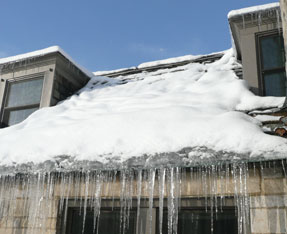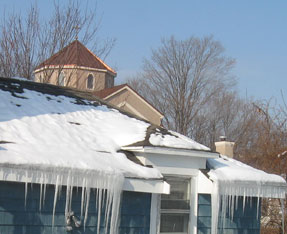Ice Damming
Ice damming is the build-up of ice on roofs, eaves (overhangs), and gutters during winter weather and is a common problem in northern climates such as Colorado and Minnesota. In cases where ice dams result from deficient construction, the underside of the roof is heated when warm air from the heated living spaces below the roof escapes into the attic spaces above. This escape of the warm air is the result of construction deficiencies, including thermal leaks, inadequate roof insulation, and/or inadequate roof ventilation. The warm air then warms the roof from below and melts snow or ice on the roof surface above. The water from the melted snow or ice, now in liquid form, makes its way down the roof, and freezes again at roof eaves (overhangs) and gutters because those areas are not above heated spaces. Because those areas are not above heated spaces, they remain below the freezing temperature, allowing the water to re-freeze. Ice dams can result in water intrusion into a building’s interior, causing damage to rafters, trusses, framing, drywall, and insulation. In addition, ice dams can fall off roofs and gutters, causing further risk of damage and risk to the safety of the building’s occupants.


